The Witchwood is out for nearly a month now, so it’s already time to look back at the pre-expansion predictions and see how close they were to the actual, post-release state of the game. I have to say that overall, the community is getting better and better at rating cards, but we still make silly mistakes – overlooking a certain card’s strength or thinking that some new reveal is stronger than it really is. In this article, and the second part which will come out very soon, I’m going to look at the cards that were underrated, or overrated by the community, talk a bit about the predictions and compare them to the current state of the game. Yes, CURRENT state of the game, because that’s the only point of comparison we have. One can always say that “X card will get stronger once Blizzard prints more synergy!” or “Y card will no longer be great after Blizzard finally nerfs Z!” – and sure, that might be right, but talking about it is pointless right now, as we don’t know the future.
In the first part, I will be looking at the most underrated cards from The Witchwood. An underrated card isn’t necessarily a card that was thought to be very weak, but turned out to be a meta-breaker. By “underrated” I simply mean a card that was rated significantly lower than its real power level – for example, a card that was rated at 2/10, but turned out to be 6/10 was underrated, even though the card might not see play in any Tier 1 deck. Similarly, a card that was rated 6/10, but turned out to be 9/10 was also underrated – even though it wasn’t rated as “garbage” at first, it still turned out to be much better.
All of the ratings were taken from the Vicious Syndicate’s Witchwood pre-release poll, which you can find here. Why from there and not from out voting system on Hearthstone Top Decks? It’s simple – because in case of the Vicious Syndicate’s poll, the voting started after the WHOLE SET was revealed, unlike here, where you could vote for the cards right away at it was revealed. A lot of the cards are rated incorrectly early, because we still don’t know the context of the entire expansion. It also closed before the expansion’s release, so not votes from people that already knew the power level of some cards slipped in. Thus, I think that it’s the best source, even though the players voting in that poll tend to be more competitive than the general playerbase. I will refer to votes from our site too, but mostly as a supplementary thing, not the main reason I put a card on one of the two lists.
P.S. Remember – the point of these articles isn’t to bash the community! My ratings for so many of the cards were wrong too (I will actually write an article looking back at my own ratings too, in a while). On top of that, the majority of the cards were predicted pretty well – but where’s the fun in talking about those?
Check out our look at the Most Overrated Cards from The Witchwood Expansion!
Darkmire Moonkin
Rated #135 out of 135
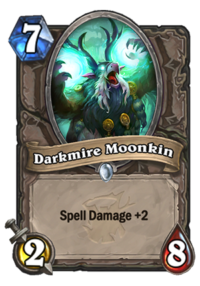
Let me clear something up first. Darkmire Moonkin is not a great card. It’s not seeing play in multiple decks, and so far it’s been played in only a single deck – Sjow’s Malygos Druid. Still, I find it absolutely amazing that a card that was considered the WORST card from The Witchwood (including votes on our site and different HS-related sites) has seen actual play, in a competitive deck used to hit Legend – and not just any Legend climb, Sjow had a 23-5 score from R4 to Legend using it.
To be completely fair, the main reason why the card works pretty well in this build is actually Master Oakheart. At 7 mana, Darkmire Moonkin is really pricey, but if you can get it out for free using Master Oakheart, both the 2/8 stats and the +2 Spell Damage part are really compelling.
After getting it out, you can immediately combo it with some of your cheaper cards – Moonfire turns into 3 damage (or even 4 if you also pull out Bloodmage Thalnos), and the Lesser Jasper Spellstone is now 4-8 damage instead of the regular 2-6, depending on the upgrade (again, 5-9 if you also pull Thalnos). Plus, since the card has quite a lot of health, and you’re often also pulling a 3/12 Taunt (Witchwood Grizzly), there is a significant chance that it sticks, resulting in some nice Swipe action next turn.
The deck won’t likely become a meta build, and outside of the Oakheart combo, the card isn’t really too powerful. But I think that’s enough proof to say that Darkmire Moonkin is certainly NOT the absolutely worst card from this expansion.
Cinderstorm
Rated #119 out of 135
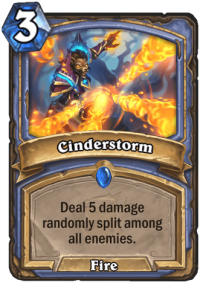
Cinderstorm was one of the lowest rated cards from The Witchwood. I also gave it 2 out of 10 if I remember correctly. The card just doesn’t seem too strong – I mean, Arcane Missiles saw really limited play besides the time when Flamewaker Tempo Mage builds were popular (and every cheap spell was great), and it just seems better. Arcane Missiles is 3 damage per mana point, while Cinderstorm is only 1 and 2/3 – that’s a massive difference in terms of tempo.
Yes, you can’t directly scale cards like that. That’s why Pyroblast costs 10 mana and not 7-8, even though that the mana cost doesn’t compare favorably to Fireball. Or, let’s say, even though 1/3 are normal stats for a 1-drop, no one would think that a 3/9 3-drop would be balanced.
Still, 5 RANDOM damage for 3 mana just doesn’t seem good. So why in the world does this card see common play in Tempo Mage? Well, there are two reasons for that. First of all – a lot of cards have rotated out, including a lot of burn. Losing Medivh's Valet and Firelands Portal meant that the deck now has less burn damage. While Cinderstorm isn’t a 100% burn card, you often want to play it on the empty board, when 5 burn damage for 3 mana is actually great – I mean, it’s a Kill Command after all. When playing Tempo Mage vs a slower deck, your opponent will often have a relatively empty board for the first few turns (or at least after a board clear), meaning that you can guarantee all of the shots hitting face quite easily, until the mid/late game.
And the second reason is the current popularity of board flood decks. Paladin is the #1 class right now, and the class relies on the board to do anything. Odd builds are flooding the board every turn, but the Even build is also quite good at doing that, thanks to the 1 mana Hero Power and Call to Arms. In those matchups, since the deck runs no AoE board clears, Cinderstorm can stabilize the early/mid game board, preventing Paladin from running over you completely. The matchup is still bad, but it’s significantly better than with the non-Cinderstorm build, which is the reason why highest win rate decks generally run Cinderstorm.
Funnily enough, that is also the reason why Avenging Wrath is a very popular choice in the Even Paladin builds, despite the damage / mana distribution being even worse.
Vicious Scalehide
Rated #99 out of 135
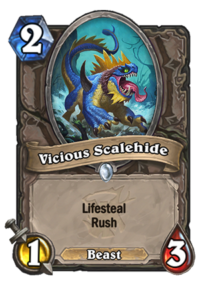
“Well, another pack filler” – that’s what most of the players thought about Vicious Scalehide before the release. 1/3 stats are terrible for a 2-drop, Lifesteal is mostly useless in the early game, and yeah, Rush is cool, but not on such a small body. But as it turned out, it’s one of the most popular The Witchwood cards played in the current meta.
A big part of its popularity comes from the fact that it’s now a staple in Quest Rogue – the deck had insane mid/late game after it manages to finish the Quest, but it’s prone to getting rushed down. Often even after you manage to finish the quest, if you’re at very low health, you still lose the game to burn damage, weapons, Charge minions etc. Vicious Scalehide lets you clear a minion immediately, while healing for 5 on top of that – more if you can bounce it. Vicious Scalehide absolutely saves you in lots of the games.
But Quest Rogue is not the only deck running this card. Some Even Paladin builds, especially those using The Glass Knight (the card is getting less and less popular, but it’s still not a bad choice), find it useful. Most importantly, it’s a good Call to Arms pull – it adds some immediate impact to the card. Plus, if it sticks, you can heal up for much more (very useful in certain matchups, like Face Hunter or Tempo Mage) if you combine it with a buff such as Blessing of Kings or Spikeridged Steed. Another Even build – Even Shaman – also utilizes it, as it gives Lifesteal to Corpsetaker and has a good combo with Flametongue Totem.
The card is not a meta breaker, and a big part of its popularity comes from the lack of better options, but it’s definitely much, MUCH more than just a pack filler.
Druid of the Scythe
Rated #90 out of 135

Druid cards often get underrated for one simple reason – many players don’t value the flexibility highly enough. The common theme of “Choose one” cards is that each individual option is weaker than a standalone card, but you can pick the right option for each situation. Druid of the Scythe is similar – neither a 2/4 Taunt or a 4/2 Rush for 3 mana is particularly powerful. Do you need to clear something immediately? Pick Rush and do it. Really great as a way to deal with those pesky Doomsayers when your opponent doesn’t think you can kill it, for example. Sometimes you even want to drop it on the curve with nothing to attack, just to put more pressure on the opponent. But let’s say that you face an aggressive deck, who has a few 1-2 health minions on the board. Now the 2/4 Taunt option can come handy. Other than that, it’s also good way to play around the AoEs – 2-3 damage ones that would kill the other form will only damage this one.
While the Rush form seems to stand out more, both of them are useful in some situations. However, the reason why this card sees play is not only its flexibility, but the fact that a “minion removal” can be really good in a deck that… can’t run spell removals. Yes, I’m obviously speaking of the Spiteful Druid. In order to maintain the Spiteful Summoner‘s and Grand Archivist‘s power level, the deck runs only a 10 mana spell – Ultimate Infestation. While some cards, such as Swipe, could fit really well into the build, you wouldn’t want to get a random 4-drop instead of a random 10-drop – it would ruin the deck’s basic strategy. However, you still want to have some ways to immediately impact that board.
And that is what makes this card good – you can use it as a 4 damage removal for 3 mana while not having to run any spells.
Scaleworm
Rated #87 out of 135
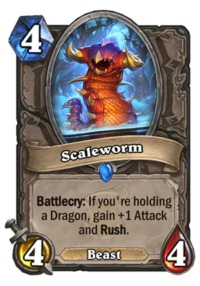
I’m not entirely sure why this card was so underrated. Maybe it’s the fact that you need to play Dragon deck in order to make it work, and that we’ve lost A LOT of powerful Dragons/Dragon synergy cards (such as Netherspite Historian, Drakonid Operative or Book Wyrm). Most of the players didn’t think that Dragon synergies will still be worth running. But it turned out that they are, especially in Priest, who still has access to Duskbreaker, another borderline broken Dragon card.
For that reason, Scaleworm has found its home in Control Priest builds trying to utilize the remaining Dragon synergies. Control Priest is currently one of the strongest meta decks, as it has good matchups against both Paladin decks AND Cube Warlock – something that rarely happens. Scaleworm, while maybe not a vital card in that deck, is actually more useful than you might think. When you drop it down on Turn 4, it can usually clear a minion (often a high priority one, such as Knife Juggler or Murloc Warleader) and survive – meaning that it often gets 2 for 1. The 1 for 1 mid game trades can also happen, and you don’t mind them at all. Past Turn 5, you can buff it with Power Word: Shield to increase the range of minions it can kill without dying, while past Turn 7 you can play it immediately with Northshire Cleric, clear something, and heal it up to draw a card, which is a quite strong play.
But Control Priest is not the only deck Scaleworm sees play in. Spiteful Summoner decks also find it useful – while Spiteful Priest is no longer a popular meta deck, certain Spiteful Druid builds run it. I’m not a big fan of this card in Spiteful Druid – not because it’s bad, but because it’s hard to fit enough Dragons into the deck to make it consistent. However, the idea itself is not bad – Spiteful decks can’t run spell removals, so Rush minions are a great way to fill that weakness.
If we look at the last few expansions, Blizzard is printing some Dragon cards or Dragon synergies every now and then, so the card might even get stronger as the time goes by.
Lifedrinker
Rated #66 out of 135
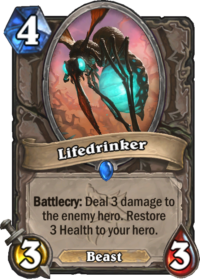
No matter if we look at the card’s popularity, or the win rates, Lifedrinker is certainly higher than in the middle of the stake. It’s probably among top 20 cards from The Witchwood. So the jump might not be as big as in some of the cards above, but I think that it is worth mentioning, especially since I undervalued the card heavily too.
I mean, when you look at it – 4 mana 3/3 are terrible stats. 3 immediate damage is okay, but since you can’t target it, it can only be used as the burn damage. And 3 healing? Well, if you play a deck who needs 3 burn damage on a 4-drop, you probably don’t need healing. That was my reasoning, and I think that lots of you also thought similar things. But as it turns out, some of the decks indeed DO need extra burn damage, and the extra body that your opponent needs to deal with is the icing on the cake. Healing part is also not completely useless – especially in mirror matchups, or against other aggressive decks, when 3 points of healing might mean an extra turn you live. All of that makes the card something better than a Nightblade reprint.
The card is mostly associated with the infamous Shudderwock Shaman OTK combo, but the deck is pretty much non-existent right now, yet Lifedrinker sees play in a bunch of other builds. Tempo Mage is most likely the best example, but not the only one. Spiteful Even Paladin builds also run it (they aren’t very popular, but have a quite solid win rate). He’s also used in some of the Zoo Warlock and Tempo Rogue builds, or, for example, in the recent non-Baku Aggro Hunter build from Senfglas.
Hench-Clan Thug
Rated #31 out of 135

I mean, #31 out of 135 is not really a bad rating, is it? You can definitely say that, but I still want to put it on the list. I believe that Hench-Clan Thug is easily among the 5 strongest cards from The Witchwood. While it doesn’t have a “global” use, it’s the main reason why non-Quest Rogue builds are still relevant. Especially the Odd Rogue builds have lots to thank this card for, as it often seals the game right when it lands on the board on Turn 3. If it can’t get answered, it has absolutely insane snowball potential.
In Rogue, since Hero Power on Turn 2 is your go-to play most of the time anyway, it’s basically a 3 mana 4/4 that gets a conditional +1/+1 every turn, but since the condition is so easy to meet, you could almost say that it gets +1/+1 per turn, period. The snowball potential is so high mostly because Rogue always has access to the weapon on Turn 2, but even decks that don’t have tried to use this card – he was pretty popular in Odd Hunter, and some Rush Warrior builds also tried it out. However, saying that he might as well be a Rogue class card and not much would change wouldn’t be a stretch.
All that said, the #31 rating on Vicious Syndicate’s poll is still quite high. The card was HEAVILY underrated by the general community. As an example, Hench-Clan Thug is currently #88 out of 135 on our site (even counting the votes made post-release), and had similarly low scores on the other Hearthstone-related sites.
Genn Greymane
Rated #24 out of 135
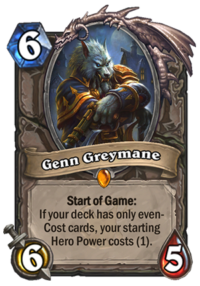
Overall, both Baku the Mooneater and Genn Greymane were rated quite highly before the release. People saw a lot of potential in the Odd & Even decks, and they were right. However, the general consensus was that Baku is THE stronger Legendary of that pair, and that the Baku decks should see much more play. And it’s somewhat true in terms of quantity – there are much more Baku Odd builds than the Even builds. However, if we look at the quality of individual decks, Genn Even Paladin beats every single one of them – it’s arguably the #1 deck on the ladder right now. Which makes Genn Greymane one of the most popular, if not THE most popular card on the ladder.
Even Paladin is so strong, because it has a cheaper Hero Power (which is important in the deck – you can squeeze it into your turns so easily, creating extra bodies all the time), while keeping most of its powerful cards, such as Call to Arms or Sunkeeper Tarim. While it has to make some sacrifices, they aren’t really significant, unlike in the Odd Paladin build (which gets a stronger Hero Power in turn).
However, Even Paladin is not the only viable Even build. Even Shaman is the strongest Shaman deck right now, and while it’s not a Tier 1 choice, mainly because of the Warlock’s popularity (it gets destroyed by all of the different board clears Warlock has access to), it’s a solid Tier 2-3 deck you can actually ladder with. Then, there is an Even Warlock, also called the new “Handlock” – the build disappeared from the ladder just as quickly as it got popular, but you can still see it every now and then.
Thanks to the Even Paladin, Genn Greymane is one of the most impactful cards from The Witchwood. Even though rating it as #24 (#51 on our site, by the way) is not THAT bad, the card definitely deserves to be higher.

I very much agree with this list. I play Tempo Mage and I rated Cinderstorm very poorly. It has become one of my favorite cards. It turns out dealing with Paladin boards is good. 5 damage for 3 mana to face is good. And basically, you just need more burn damage spells since others rotated out. I also never thought Lifedrinker would be a competitive card, and there I am using it in the deck. I’m also using Black Cat in a non-Odd deck (!).
I don’t know who could rate Hench-Clan Thug lowly. For me it was a clear 5/5 stars from just seeing it. A 3 mana 4/4 would already be very solid. The snowballing potential it carries aditionally makes it super strong.
And Vicious Scalehide… We all thought it would be another Swamp Leech. It turns out that killing Dudes immediately and gaining a lot of life after being buffed is actually really good.
You mean you play non interactive, spell face mage :p
I prey on Warlocks and Quest Rogues, yes. It’s satisfying to punish them for playing those decks. 😉
If you play Druid, Warrior and Priest you can definitely interact by healing your face. Paladins don’t usually run healing but they’re slightly favored anyway. Tempo Mage matches are always very interesting, it’s not as trivial to trade minions or not, and how you interact with Counterspells and Explosive Runes is always exciting.
“how you interact with Counterspells and Explosive Runes is always exciting.” … rather depends on your point of view; I just find them frustrating to play against when they’re dropped early. You don’t have many options early-game and both of them prevent you from gaining control of the board until it’s too late to matter – which can be as early as turn 5 or 6.
T2 Arcanologist -> T3 Kirin Tor Mage is pretty much game over.
Have you tried piloting Tempo Mage yourself? Really, it’s not as easy as it seems. The mulligan is already very important (most other aggro decks have plenty of 1-drops, and you need to consider whether to keep certain spells or not). Also, having the Secret you want by Turn 3 only happens 30% of the time. You have to consider putting down the undesired secret or not. And if you don’t get Aluneth or Arcane Intellect by Turn 5 you run out of steam. “T2 Arcanologist -> T3 Kirin Tor Mage is pretty much game over.” is absolutely not a true statement.
I think Tempo Mage is also good because I’ve seen many people misplay into it, even in Rank 5. Like using the Coin before I put down a Secret (you 90% of the time need it to proc the first secret). Another time I saw a Druid of the Scythe in Rush form when Explosive Runes was up – you always put the Taunt form in that case. Sure, it sucks when you don’t know which secret it is, but that’s when you have to weigh the risks! Personally I believe every class should have access to secrets, since HS in general is an uninteractive card game and secrets are the only way to immediately interact with your opponent during their turn.
@GlosuuLang – yes, I got my first Golden Hero using Tempo Mage a few months ago; the deck has changed slightly since then as Explosive Runes and Aluneth didn’t exist, Ice Block and Kabal Crystal Runner were still in rotation – compared to any Control and most Combo decks it’s still an easy deck to pilot.
T2 Arcanologist -> T3 Kirin Tor Mage is an incredibly strong opener (even more so if you dropped Mana Wyrm on T1 as it has to be removed before it snowballs); it really cripples your opponent’s next turn – especially if they don’t have the Coin to discard into Counterspell. Odds are they’re going to have to drop a cheap minion and hope for Counterspell – or suck up 3-5 face damage and just hand the turn over; at which point they’re on about a 4-turn clock.
Though even if it was Counterspell, that often means whatever they’ve dropped is about to eat a Frost Bolt so you maintain the board and tick the clock down a turn.
OK – you might eat dirt with Tempo Mage vs the current crop of Paladin board flood decks but with a good opener you’re going to trounce most slower decks as you restrict their ability to both play minions and cast spells; you should win before they can play around the secrets and gain board control.